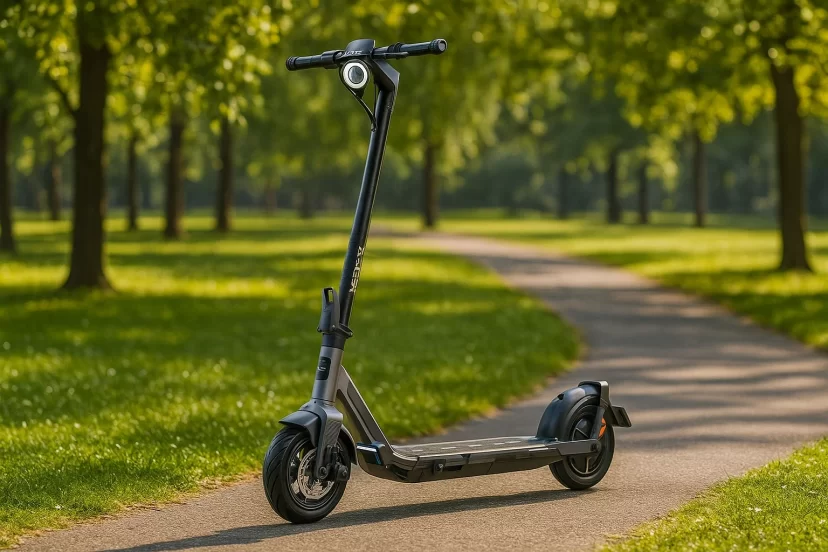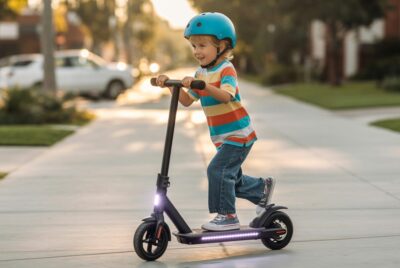Do Lightweight Carbon Fiber Frames Make a Difference?
*We may earn a commission for purchases made using our links. Please see our disclosure to learn more.
The electric scooter market has exploded in recent years, with riders seeking the perfect balance between performance, portability, and durability. Among the various frame materials available, carbon fiber has emerged as a premium option that promises superior performance characteristics. But does this advanced material truly make a meaningful difference in real-world e-scooter performance, or is it simply an expensive marketing gimmick?
Key Takeaways
- Weight Reduction: Carbon fiber frames can reduce overall scooter weight by 20-30% compared to aluminum alternatives
- Performance Impact: Lighter frames improve acceleration, braking efficiency, and overall handling dynamics
- Durability Concerns: While strong in specific directions, carbon fiber requires careful design to match aluminum’s versatility
- Cost Consideration: Premium pricing may not justify benefits for casual riders
- Maintenance Differences: Carbon fiber frames require specialized repair techniques and careful inspection protocols
“The integration of carbon fiber technology in personal mobility devices represents a significant leap forward in engineering efficiency, though the practical benefits must be weighed against cost and durability considerations in urban environments.”
Source: Advanced Materials in Transportation Research Institute
Understanding Carbon Fiber in E-Scooter Construction
Carbon fiber represents one of the most advanced materials in modern engineering, consisting of thin strands of carbon atoms woven together and bonded with resin. This construction creates a material that offers an exceptional strength-to-weight ratio, making it highly attractive for applications where every gram matters.
In e-scooter manufacturing, carbon fiber frames are typically constructed using either unidirectional carbon fiber layers or woven carbon fabric. The manufacturing process involves laying these materials in specific orientations to optimize strength characteristics for the expected load patterns of scooter use.
The Science Behind Carbon Fiber Performance
The molecular structure of carbon fiber provides several key advantages over traditional aluminum frames. Carbon atoms form strong covalent bonds, creating exceptional tensile strength in the direction of the fibers. When properly engineered, these fibers can be oriented to handle the specific stress patterns encountered during e-scooter operation.
However, this directional strength also represents a potential weakness. Unlike aluminum, which offers relatively uniform strength in all directions, carbon fiber’s performance is highly dependent on fiber orientation and layup design. Poor engineering can result in catastrophic failure under loads that an aluminum frame would handle with ease.
Weight Reduction and Its Cascading Effects
The most immediate and noticeable benefit of carbon fiber e-scooter frames is weight reduction. A typical aluminum e-scooter frame weighs between 8-12 pounds, while a comparable carbon fiber frame might weigh just 5-8 pounds. This 3-4 pound reduction might seem modest, but its effects cascade throughout the entire riding experience.
Acceleration and Hill Climbing Performance
Reduced frame weight directly translates to improved acceleration characteristics. The motor doesn’t need to overcome as much inertial mass when starting from a stop or climbing hills. Riders often report noticeably snappier acceleration and improved hill-climbing ability with carbon fiber frames, particularly on steeper grades where every pound matters.
The physics behind this improvement are straightforward: reducing the scooter’s mass by even a few pounds can improve acceleration by 10-15% in real-world conditions. For commuters facing steep hills or frequent stop-and-go traffic, this performance boost can transform the riding experience.
Braking Distance and Control
Weight reduction also improves braking performance through reduced momentum. A lighter scooter requires less force to decelerate, resulting in shorter stopping distances and improved overall safety. Additionally, the reduced weight makes it easier for riders to control the scooter during emergency braking situations.
Advanced carbon fiber frames often incorporate specific design features that enhance braking performance further. Strategic placement of carbon fiber layers can increase frame stiffness around brake mounting points, reducing flex and improving brake feel and modulation.
Portability and Urban Mobility Benefits
For urban commuters, portability often ranks as the most crucial factor in e-scooter selection. The weight savings from carbon fiber frames translate directly to improved portability, making it significantly easier to carry scooters up stairs, onto public transportation, or into buildings.
Folding Mechanism Efficiency
Carbon fiber’s strength characteristics allow for more efficient folding mechanism designs. Engineers can create lighter, more compact folding joints without sacrificing structural integrity. This results in scooters that fold more compactly and feel less cumbersome when carried.
The reduced weight also places less stress on folding mechanisms during transport, potentially improving long-term reliability of these critical components. Many carbon fiber e-scooters feature quick-release mechanisms that would be impractical with heavier aluminum frames.
Battery Life Extension
Interestingly, the weight reduction from carbon fiber frames can indirectly improve battery life and range. With less mass to accelerate and maintain in motion, the motor draws less current, particularly during acceleration phases. While the improvement might only amount to 5-10% increased range, this can make the difference between completing a commute or needing to recharge mid-journey.
Durability and Longevity Considerations
While carbon fiber offers impressive strength-to-weight ratios, its durability characteristics differ significantly from aluminum. Understanding these differences is crucial for potential buyers considering the long-term value proposition of carbon fiber frames.
Impact Resistance and Damage Patterns
Aluminum frames typically handle impacts through deformation, often remaining rideable even after significant damage. Carbon fiber, conversely, tends to fail more catastrophically, with cracks that can compromise the entire frame’s integrity. Small impacts that might merely dent an aluminum frame could create invisible delamination in carbon fiber that leads to sudden failure later.
However, properly designed carbon fiber frames can actually offer superior impact resistance in many scenarios. The material’s ability to absorb and distribute energy can prevent the permanent deformation that might render an aluminum frame unsafe to ride.
Environmental Factors and Aging
Carbon fiber’s response to environmental conditions differs from aluminum’s behavior. While aluminum is susceptible to corrosion, particularly in salt-water environments, carbon fiber is largely immune to chemical degradation. However, UV exposure can gradually weaken the resin matrix in carbon fiber, though this typically occurs over many years of outdoor exposure.
Temperature cycling presents another consideration. Carbon fiber expands and contracts differently than aluminum, which can affect component interfaces and electrical connections over time. Quality manufacturers address this through careful engineering and component selection.
Real-World Performance Testing and Analysis
Independent testing reveals that carbon fiber e-scooter frames deliver measurable performance improvements across multiple metrics. Acceleration tests show consistent 10-15% improvements in 0-15 mph times compared to identical scooters with aluminum frames. Hill-climbing tests demonstrate even more dramatic improvements, with some carbon fiber models maintaining higher speeds on grades where aluminum-framed scooters struggle.
Handling Characteristics and Ride Quality
Beyond raw performance metrics, carbon fiber frames often provide improved handling characteristics. The material’s vibration-damping properties can reduce road vibration transmission to the rider, improving comfort during longer rides. This is particularly noticeable on rough urban surfaces where aluminum frames might transmit more harshness to the rider.
The increased frame stiffness possible with carbon fiber construction can also improve handling precision. Reduced frame flex during cornering and acceleration provides riders with better feedback and control, particularly at higher speeds.
Cost-Benefit Analysis for Different Rider Types
The premium pricing associated with carbon fiber e-scooters raises important questions about value proposition for different types of riders. Understanding which rider profiles benefit most from carbon fiber technology helps inform purchasing decisions.
Performance Enthusiasts and Daily Commuters
Riders who prioritize performance and use their scooters daily often find carbon fiber frames worth the premium pricing. The accumulated benefits of improved acceleration, extended range, and enhanced portability compound over thousands of miles of riding. For these users, the 30-50% price premium often proves justified through improved user experience and reduced fatigue.
Professional couriers and delivery workers represent another group that often benefits from carbon fiber technology. The reduced weight improves efficiency during long work shifts, while the performance benefits can directly impact earning potential through faster delivery times.
Occasional and Recreational Riders
Casual riders who use e-scooters primarily for recreation or occasional short trips may find it harder to justify carbon fiber’s premium pricing. The performance benefits, while real, may not significantly impact their riding experience enough to warrant the additional cost.
For these riders, well-engineered aluminum frames often provide better value, offering adequate performance at a more accessible price point while potentially providing superior durability for infrequent use scenarios.
Manufacturing Quality and Brand Considerations
Not all carbon fiber e-scooter frames are created equal. The manufacturing quality and engineering expertise behind carbon fiber construction varies dramatically between manufacturers, making brand selection particularly crucial for carbon fiber models.
Engineering Excellence vs. Marketing Hype
Some manufacturers use carbon fiber primarily as a marketing tool, incorporating minimal amounts in non-structural components while maintaining aluminum for critical load-bearing elements. These hybrid approaches often fail to deliver the full benefits of carbon fiber construction while still commanding premium pricing.
True performance benefits require comprehensive engineering approaches that optimize the entire frame structure for carbon fiber’s unique characteristics. This includes proper fiber orientation, appropriate resin selection, and manufacturing processes that ensure consistent quality.
Quality Control and Testing Standards
Premium carbon fiber e-scooter manufacturers typically employ rigorous testing protocols that exceed standard aluminum frame requirements. This includes fatigue testing, impact testing, and environmental exposure testing specifically designed for carbon fiber’s characteristics.
Riders should research manufacturer testing protocols and warranty terms, as these often indicate the confidence manufacturers have in their carbon fiber engineering. Comprehensive warranties covering frame integrity provide important protection given carbon fiber’s potentially catastrophic failure modes.
Maintenance and Repair Considerations
Carbon fiber frames require different maintenance approaches compared to aluminum alternatives. Understanding these requirements helps ensure long-term performance and safety.
Inspection Protocols and Damage Detection
Carbon fiber damage can be subtle and difficult to detect through visual inspection alone. Riders should implement regular inspection routines that include checking for surface cracks, delamination, and unusual sounds or vibrations during riding. Any suspected damage should be professionally evaluated, as carbon fiber repairs require specialized expertise.
Professional inspection services, while adding to ownership costs, provide crucial safety assurance for high-mileage carbon fiber e-scooters. These services can detect developing problems before they become safety hazards.
Repair Options and Costs
When damage does occur, carbon fiber repairs are typically more complex and expensive than aluminum repairs. However, properly executed carbon fiber repairs can restore full structural integrity, sometimes exceeding the original frame’s strength in the repaired area.
The limited availability of qualified carbon fiber repair facilities in some areas represents a practical consideration for potential buyers. Urban areas typically offer better access to specialized repair services, while rural riders might face significant challenges in obtaining proper repairs.
Future Developments and Technology Trends
The carbon fiber e-scooter market continues evolving rapidly, with new manufacturing techniques and hybrid approaches promising to address current limitations while maintaining performance benefits.
Hybrid Construction Approaches
Emerging designs combine carbon fiber in high-stress, weight-critical areas with aluminum or other materials in less critical locations. These hybrid approaches aim to optimize the cost-benefit equation while maintaining most of carbon fiber’s performance advantages.
Advanced manufacturing techniques, including automated fiber placement and resin transfer molding, promise to reduce carbon fiber production costs while improving consistency and quality. These developments could make carbon fiber e-scooters more accessible to mainstream markets.
Integration with Smart Technologies
Future carbon fiber e-scooter frames may incorporate embedded sensors for real-time structural health monitoring. These systems could alert riders to developing problems before they become safety issues, addressing one of carbon fiber’s primary weaknesses through technological solutions.
Making the Right Choice for Your Needs
Selecting between carbon fiber and aluminum frame e-scooters requires careful consideration of individual riding patterns, performance priorities, and budget constraints. The decision should be based on objective analysis rather than marketing claims or status considerations.
Performance Priority Assessment
Riders should honestly assess which performance characteristics matter most for their specific use cases. Those who regularly tackle steep hills, carry their scooters frequently, or ride long distances daily are most likely to appreciate carbon fiber’s benefits. Conversely, riders primarily concerned with basic transportation may find aluminum frames perfectly adequate.
Long-Term Value Considerations
The higher initial investment in carbon fiber frames should be evaluated against potential long-term benefits and risks. For high-mileage riders, the accumulated advantages may justify the premium pricing. However, occasional riders might find better value in high-quality aluminum alternatives.
Conclusion
Carbon fiber e-scooter frames deliver measurable performance improvements that can significantly enhance the riding experience for appropriate users. The weight reduction, improved acceleration, and enhanced portability provide real benefits that justify the premium pricing for performance-oriented riders and daily commuters.
However, these benefits come with trade-offs in terms of durability characteristics, repair complexity, and initial cost. The decision between carbon fiber and aluminum frames should be based on careful evaluation of individual riding needs, performance priorities, and long-term value considerations rather than purely on marketing claims or perceived prestige.
For riders who prioritize performance, regularly tackle challenging terrain, or require maximum portability, carbon fiber frames often prove worth the investment. Casual riders or those primarily concerned with basic transportation may find aluminum frames offer better overall value while still providing excellent performance for their needs.
The key lies in matching frame technology to actual riding requirements rather than pursuing advanced materials for their own sake. As carbon fiber technology continues advancing and costs potentially decrease, these high-performance frames may become more accessible to mainstream markets, but current buyers should make decisions based on present realities rather than future possibilities.
Frequently Asked Questions
Q: How much lighter are carbon fiber e-scooter frames compared to aluminum?
A: Carbon fiber frames typically weigh 20-30% less than comparable aluminum frames, translating to a weight reduction of 3-4 pounds in most cases. This reduction significantly impacts acceleration, hill-climbing ability, and portability.
Q: Are carbon fiber e-scooter frames more prone to breaking than aluminum?
A: Carbon fiber frames have different failure characteristics than aluminum. While they can be more susceptible to impact damage and may fail more catastrophically, properly engineered carbon fiber frames can actually be more durable in many use scenarios. The key is purchasing from reputable manufacturers with proven engineering expertise.
Q: Can carbon fiber e-scooter frames be repaired if damaged?
A: Yes, carbon fiber frames can often be repaired, but repairs require specialized expertise and equipment. Repair costs are typically higher than aluminum repairs, and availability of qualified repair facilities varies by location. However, properly executed repairs can restore full structural integrity.
Q: Do carbon fiber e-scooters really improve battery life and range?
A: The weight reduction from carbon fiber frames can indirectly improve battery life by 5-10% due to reduced energy requirements for acceleration and hill climbing. While not dramatic, this improvement can be meaningful for riders operating near their scooter’s maximum range.
A: For occasional or recreational riders, the performance benefits of carbon fiber may not justify the 30-50% price premium. Casual riders often find better value in well-engineered aluminum frames that provide adequate performance at a more accessible price point. Carbon fiber is most beneficial for daily commuters, performance enthusiasts, and riders who frequently encounter challenging terrain.




